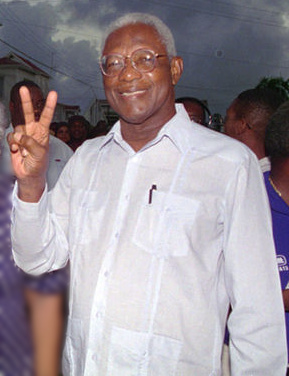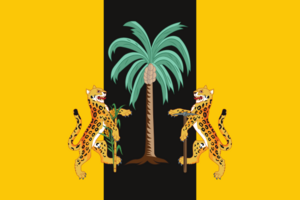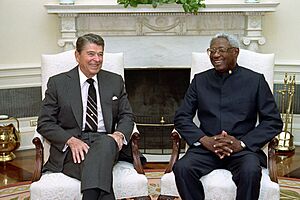Desmond Hoyte facts for kids
Quick facts for kids
Desmond Hoyte
|
|
|---|---|

Hoyte in 1997
|
|
| 3rd President of Guyana | |
| In office 6 August 1985 – 9 October 1992 |
|
| Prime Minister | Hamilton Green |
| Vice President | Hamilton Green Mohamed Shahabuddeen Ranji Chandisingh Viola Burnham |
| Preceded by | Forbes Burnham |
| Succeeded by | Cheddi Jagan |
| 3rd Prime Minister and First Vice President of Guyana | |
| In office 16 August 1984 – 6 August 1985 |
|
| President | Forbes Burnham |
| Preceded by | Ptolemy Reid |
| Succeeded by | Hamilton Green |
| Personal details | |
| Born | 9 March 1929 Georgetown, British Guiana |
| Died | 22 December 2002 (aged 73) Georgetown, Guyana |
| Resting place | the Botanical Gardens |
| Political party | People's National Congress |
| Spouse | Joyce Hoyte |
Hugh Desmond Hoyte (born March 9, 1929 – died December 22, 2002) was an important political leader in Guyana. He served as the Prime Minister of Guyana from 1984 to 1985. After that, he became the President of Guyana and held that position from 1985 until 1992.
Contents
Early Life and Education
Desmond Hoyte was born in Georgetown, which was then called British Guiana. This happened on March 9, 1929. He came from a family that was not rich but also not poor.
He went to St Barnabas Anglican School and Progressive High School. In 1948, he started working for the government. Later, he became a teacher in Guyana and Grenada. While teaching, he studied hard and earned a Bachelor of Arts degree from the University of London in 1950.
In 1957, he traveled to the United Kingdom to study law. He passed his law exams at the Middle Temple and received his law degree in 1959. In 1960, he joined a law firm with Forbes Burnham, who would later become a president. Hoyte then started his own law practice. He became a leader in the Guyana Bar Association, which is a group for lawyers. He also gave legal advice to the Guyana Trades Union Congress, a group that helps workers.
In 1962, he joined the General Council of the People's National Congress (PNC) political party. In 1966, he was chosen to be part of the National Elections Commission. This group helped to manage the 1968 Guyanese general election.
Hoyte's Political Career
After being part of the PNC's general council, Desmond Hoyte became a member of Parliament in 1968. Soon after, he joined the government's cabinet. He held several important jobs:
- Home Affairs Minister: 1969 to 1970
- Finance Minister: 1970 to 1972
- Works and Communications Minister: 1972 to 1974
- Economic Development Minister: 1974 to 1980
As Economic Development Minister, Hoyte helped the government take control of important industries like bauxite (used to make aluminum) and sugar. This was part of a plan to have the government control more of the economy. In 1973, he became a member of the PNC's main committee.
After the election in December 1980, he became one of five vice-presidents. His job was to plan the economy, manage money, and help different regions of the country grow.
In August 1984, Hoyte became the Prime Minister of Guyana and the first Vice President. He took over from Hamilton Green.
In 1985, a sad event happened to Hoyte. His two daughters, Amanda and Maxine, died in a car crash. This happened on April 30 while they were traveling to hear him give a speech. His sister-in-law and driver also died. His wife, Joyce, was the only person who survived the accident.
Becoming President of Guyana
When President Forbes Burnham passed away on August 6, 1985, Desmond Hoyte became the third President of Guyana. Before Burnham's death, he and other PNC members had started talking with the opposition People's Progressive Party. They wanted to find ways to unite the country and solve its problems.
President Hoyte said he would continue these discussions. He also announced that a new general election would be held on December 9. People had criticized past elections for not being fair. Hoyte agreed to make some changes to improve the election process.
Right after becoming President, Hoyte made some big changes. He allowed certain imported foods back into the country. He also made it easier for Guyana to trade with other countries around the world.
In July 1987, Hoyte welcomed Oliver Tambo, the leader of the African National Congress, for a visit. This showed how Guyana supported the fight for freedom in Southern Africa. Also in 1987, Hoyte created the Guyana Prize for Literature, which honors great Guyanese writers.
In 1989, Hoyte suggested creating a special area to protect the Guyanese rainforest. This idea later became the Iwokrama Forest, a large conservation area.
Hoyte also served as the Minister of Foreign Affairs from 1990 to 1992. During his time as president, serious crime went down. However, he faced challenges in reducing corruption within the government.
President Hoyte used the strong powers of the presidency to change some policies. These policies had been put in place by the previous president and had led to high poverty and debt. He invited foreign companies to invest in Guyana. He also worked with the International Monetary Fund, which is a global financial organization. These actions made some people in his own party unhappy.
During his presidency, Guyana's important sugar industry started to do much better. The Omai Mine, which was very important for the economy, also opened and began producing gold.
Hoyte tried to improve relations between different ethnic groups in Guyana, especially between Afro-Guyanese and Indo-Guyanese people. Some people even jokingly called him "Desmond Persaud" because they thought he treated Indo-Guyanese people better. Hoyte also brought back freedom of the press, meaning newspapers and media could report more freely.
1992 General Election
In 1990, President Hoyte announced important changes to the election rules before the 1992 election. These changes were influenced by former U.S. President Jimmy Carter. The new rules included:
- The military could not provide election services, except for security.
- Votes would be counted right at the polling places.
- An independent election commission would be set up.
- Changes were made to ballots and ballot boxes.
According to Hamilton Green, Jimmy Carter himself announced that people living overseas would no longer be allowed to vote in Guyanese elections. This overseas voting had been used to unfairly influence the 1968 Guyanese general election.
Because of Hoyte's changes, the 1992 Guyanese general elections were considered the first truly free and fair elections since 1964. As the election day approached, Hoyte believed his party could win fairly. However, on election day, it became clear that his party was likely to lose. Some PNC supporters went to the election commission's office to try and stop the vote count. Hoyte quickly announced that he would resign if these actions continued, which stopped the protest.
The election in October 1992 was won by the People's Progressive Party, led by Cheddi Jagan. President Hoyte accepted his defeat.
After the Presidency
Even after his presidency, Desmond Hoyte remained the leader of the PNC party until he passed away. He also served as the Minority Leader and Leader of the Opposition in Parliament.
In 1994, the PNC party split. A new party was formed by Hamilton Green after he was removed from the PNC. This happened because Green disagreed publicly with Hoyte about election changes and party rules. Green's new party, Good and Green Georgetown, won the local elections in Georgetown. They beat both the PNC and the PPP.
Hoyte ran for president again in 1996 and 2001. He came in second place both times.
As the opposition leader, Hoyte sometimes blocked new ideas from the ruling party. This included changes to the constitution and setting up a commission on race relations. He also tried to challenge the results of the 1997 elections. He often spoke out about Afro-Guyanese people not getting enough government jobs. After the 2001 elections, Hoyte's PNC party refused to take their seats in Parliament for a time. Bharrat Jagdeo, the new President, held talks with Hoyte in 2001 to try and make peace, but they were not successful.
Desmond Hoyte passed away from heart failure in Georgetown, Guyana, on December 22, 2002. He was 73 years old. His burial place is in the Botanical Gardens.
Personal Life
Desmond Hoyte married Joyce Noreen De Freitas in 1965. His wife, Joyce, passed away on February 14, 2011, at the age of 77. Hoyte also had a sister named Patricia. The Hoyte family lived on North Road in Georgetown. In 2016, their home was turned into a museum and library to honor him.
See also
 In Spanish: Desmond Hoyte para niños
In Spanish: Desmond Hoyte para niños



